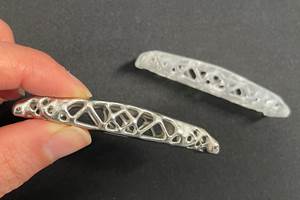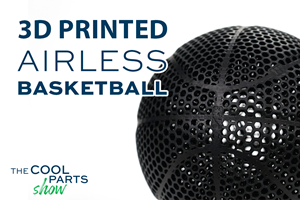Large-Volume VFGF 3D Printer Produces Modular Helicopter Cockpit Simulator
The Queen 1 VFGF system from Q.BIG 3D produced a complete modular helicopter cockpit simulator in just over a month, all while offering high surface quality, fast build rates and lightweight construction.
The 3D manufactured cockpit frame assembly made of a partially aromatic polyamide with 25% glass fiber content (Q.mid GF25). Source: Q.BIG 3D
Q.BIG 3D’s Queen 1 variable fused granulate fabrication (VFGF) system was able to achieve a new level in 3D extrusion additive manufacturing (AM) with the production of a complete modular helicopter cockpit simulator assembly in just over a month, all while offering fast build speeds, high surface quality and dimensional accuracy with constant gap dimensions.
Reiser Simulation and Training, in Berg, Germany, commissioned Murtfeldt Additive Solutions (Murtfeldt AS) in Kusterdingen, Germany, to produce a modular cockpit for a full-flight helicopter simulator. The cockpit was successfully manufactured at Murtfeldt on a Queen 1 system via a VFGF process for large-volume 3D extrusion printing.
The project aim was to overcome the limitations of conventional manufacturing strategies, such as classic mold-based processes (especially for large-volume components), which can incur high tooling costs and long lead times. According to the companies, that might mean a project like this could take 3-6 months to complete.
In addition, conventional fused deposition modeling (FDM) printers usually cannot produce large-volume 3D components, often have uneconomical build rates and also use material containing filaments which can be seven times more expensive per kilogram compared to a plastic granulate 3D printer.
In contrast, the 3D extrusion production process eliminates tooling costs while enabling new build strategies for novel component geometries combined with shorter amortization periods. When compared to alternative AM strategies (such as FDM printers), this technology can use commercially available standard granulate without filaments, thereby saving material costs.
The 3D cockpit was made by additively manufacturing all assembly components with final cockpit dimensions of 2,260 × 1,780 × 1,705 mm. The cockpit weighs only 200 kg as the 3D printing enabled a resource-saving lightweight build. Murtfeldt AS used a partially aromatic polyamide with 25% glass fiber content (Q.mid GF25) for the cockpit frame. With 0% lengthwise and 0.2% crosswise fibers, it is said this material has particularly high dimensional stability, high temperature stability up to 200°C, high stiffness and excellent paintability.
Although the manufacture of all components took just over a month, Murtfeldt AS expects shorter build times for a follow-up project by optimizing the process chain. A printer network comprising several Queen 1 machines can also shorten the delivery time for time-critical requests. The longest single build job was almost 100 hours.
Michael Ortmann, from Reiser Simulation and Training, was responsible for the design and development, and says the advantages of 3D extrusion printing offered a number of potential benefits that previously did not seem possible. “Extremely short time-to-market, high build speed, lightweight construction, bionics, functional integration and cost-effective manufacturing without the need for molds along with the merits of using granulates, to name just a few aspects,” Ortmann says.
In addition, the process provided control of distortion in the large and complex components, tight tolerances of gap dimensions and high surface quality. Dimensional accuracy was also of fundamental importance for screw fastenings and precise pinning.
Reassembling the demountable module at the user’s location was also advantageous, along with the fact that two helicopter models (Airbus Helicopters H135 and H145) could be cost-effectively simulated using a conversion kit. Also, functional integration (such as integrated cable races) are possible because of the segmentation of the 3D assembly. Overall, there are significant price advantages for the finished assembly for suppliers and end users while, at the same time, the cockpit is available at very short notice.
Certain features of the Queen 1 3D extrusion printer offered advantages for this production process:
- High surface quality, even in the case of the geometry’s strong overhangs.
- A high degree of accuracy of fit of the components in the assembly (dimensional accuracy, small gaps) due to the active temperature control of an outer chamber as well as the build space, which made a stable and repeatable process possible.
- Temperatures of not only the build space but also the entire mechanical system are kept constant, regardless of temperature fluctuations in the production hall itself.
- The variable nozzle is a key feature. The fast build rates are due to a variable nozzle control system, which adapts to the particular characteristics of each geometry. Delicate areas of the components are built up in the normal nozzle mode. Large infill areas on the thick pillars of the cockpit, however, are created in a fast turbo mode in order to reduce the build duration while at the same time increasing stability. Modes change automatically.
- In terms of design, Reiser specified sensitive areas for the nozzle control. For example, solid material was specified at the mounting points of the door hinges. This enabled greatly reduced build times compared to continuous nozzle use, as well as material-saving lightweight construction of the 3D components.
The team also noted that using the Queen 1 system technology with no tooling costs enables users to have a low investment risk and eliminate postprocessing costs. This strategy also offers advantages over competing AM strategies, such as SLS or FDM printing, which mean that components often have to be glued together. This can result in disadvantages in terms of functionality, tightness of fit and dimensional accuracy due to imprecise tolerances.
“With the innovative VFGF system technology from Q.BIG 3D for large-volume 3D components, we at Murtfeldt can specifically tap into further areas of application for the VFGF manufacturing strategy,” says Johannes Matheis, Murtfeldt AS managing director. “If you master the entire process chain, complex, large 3D components with high repeatability and component quality on a new level are possible.”
Related Content
Possibilities From Electroplating 3D Printed Plastic Parts
Adding layers of nickel or copper to 3D printed polymer can impart desired properties such as electrical conductivity, EMI shielding, abrasion resistance and improved strength — approaching and even exceeding 3D printed metal, according to RePliForm.
Read More3D Printing with Plastic Pellets – What You Need to Know
A few 3D printers today are capable of working directly with resin pellets for feedstock. That brings extreme flexibility in material options, but also requires greater knowledge of how to best process any given resin. Here’s how FGF machine maker JuggerBot 3D addresses both the printing technology and the process know-how.
Read MoreWhat Does Additive Manufacturing Readiness Look Like?
The promise of distributed manufacturing is alluring, but to get there AM first needs to master scale production. GKN Additive’s Michigan facility illustrates what the journey might look like.
Read MoreAirless Basketball Shows Promise of 3D Printed Lattices: The Cool Parts Show Bonus
Successfully matching the performance of a standard basketball demonstrates the control possible over the mechanical properties of digital materials.
Read MoreRead Next
GE Additive Rebrands as Colibrium Additive
As part of the brand name transition, both the Concept Laser and Arcam EBM legacy brands will be retired.
Read More3D Printing Brings Sustainability, Accessibility to Glass Manufacturing
Australian startup Maple Glass Printing has developed a process for extruding glass into artwork, lab implements and architectural elements. Along the way, the company has also found more efficient ways of recycling this material.
Read MoreTo Improve Performance of Compression Molded Composites, Add 3D Printed Preforms
9T Labs' Additive Fusion Technology enables the manufacture of composite structures with as much or as little reinforcement as is necessary, using 3D printed continuous fiber preforms to add strength just where needed.
Read More














.jpg;maxWidth=300;quality=90)











